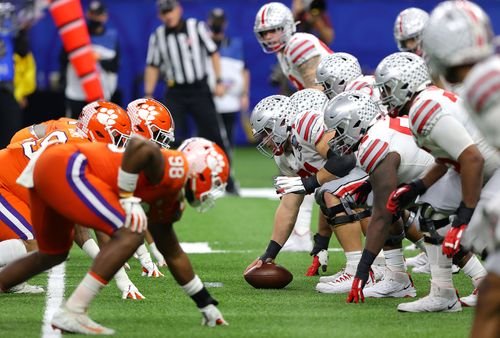The academic gap between Black and White college football players grew in 2020, report says

College students faced unprecedented challenges in 2020 as the Covid-19 pandemic swept across the country, prompting remote-learning provisions and shortening athletics seasons.
For student-athletes playing football at bowl-bound schools, those changes coincided with a poor year for academic performance, the latest edition of an authoritative annual study has found.
The overall academic performance of football players showed a year-on-year decline for the first time since 2009, according to the study produced by the University of Central Florida’s Institute for Diversity and Ethics in Sport.
The institute, led by human rights scholar Richard Lapchick, is one the country’s premier programs for the study of attitudes and practices in collegiate and professional sports.
Its latest report, “Keeping Score When It Counts: Assessing the Academic Records of the 2020-2021 Bowl-Bound College Football Teams,” reveals a downturn in academic performance and graduation rates across college campuses. But the data also show a widened achievement gap between Black and White college players.
Although every participating college reported graduation rates of at least 50%, “the gap between White and Black football student-athletes continues to be a major issue,” Lapchick said in a statement.
The gap this year is 16.3, up from 15.6% the previous year, with White student football payers posting a graduation rate of 89.7%, while the rate for their Black counterparts was 73.4%.
“It must be emphasized that Black and White football players graduate at a higher rate than their male non-athletic peers in the student body within (Division I) schools. The graduation rate for Black male students as a whole is only 42%, in comparison to the 67% graduation rate for white male students,” said Lapchick.
The institute works in partnership with the NCAA to complete report cards among member schools. For reference, the overall football student-athlete graduation success rate in 2009 was 65.5%, a full 12.5 percentage points below where it was in 2020.
“This is the first time that the overall football student-athlete (graduation success rate) has decreased from the previous year since the statistic was first reported in the 2009 bowl-bound report,” Lapchick told CNN.
Much of this new data is reflective of issues of which these schools were already aware. Many of their top players come in with the weight of racial and economic disparities already impacting academic outcomes. Although many of these students hope to become professional athletes after graduation, the odds are not in their favor.
The NCAA includes over 380,000 student athletes at more than 1,000 member colleges and universities. Of those, fewer than 2% will ever go on to professional sports.
“Ninety-eight percent of FCS football players won’t play in the pros. Even of the 2% who do, the average lifespan of a professional athlete in the NFL is less than four years. So, if they don’t have the background educationally to do something else professionally, they’re going to have limited opportunities once their playing days are over.”
The common goal of the NCAA and the institute is to ensure that student-athletes’ opportunities for success do not end after their last game.
Experts at the institute hope that schools will see the academic decline as an opportunity to improve how they reach their student-athletes. Considering the profitability and value of Division I sports programs at their respective schools, some believe that more sports revenue should be redirected to facilitate new academic resources.
In an article for ESPN.com, Lapchick writes, “The NCAA should consider implementing measures that dictate a portion of the revenue distribution be put toward academic development in addition to these athletics-driven initiatives.”
Currently, the NCAA tracks academic performance with a metric known as the Academic Progress Rate, or APR. The APR holds each team accountable for the success of student-athletes in the classroom.
Individual teams are penalized if they fall below an APR score of 930, which is an expected graduation rate of 50% of its student-athletes. Up to 10% of scholarships can be taken away. Teams can also be subject to historical penalties for poor academic performance over time.
However, experts like Lapchick propose that the onus falls on each school’s athletic department.
“The accountability falls on the student-athlete to be industrious in the classroom, on admissions offices to accept students who have a reasonable chance to succeed at their respective institutions, and on the student-athlete support system to give the assistance necessary to assure the student-athlete completes their educational goals. Athletic departments must make it a priority to provide the best student-athlete experience possible, and this starts with fostering success off the field of play,” Lapchick writes in the ESPN.com report.